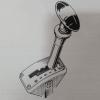Hello all,
I didn't find anything about this but perhaps I'm the only one that thinks the standard interior light is about as much use as a birthday cake candle in a coal mine?
Anyway I've found a cheap and simple(ish) way (for the later type of interior light assembly, at least) to greatly improve the interior light's brightness using an LED bulb. It shouldn't cause overheating and, if I can do it, anyone can!... in any case, I thought it was a nice little project.
BENEFITS
LED (Light Emitting Diode) bulbs offer improved brightness with significantly reduced current consumption (you can even find bulbs in different colours, if that's your taste!). The reduced current draw means lower heat generation and longevity, and, if we ever use the interior light, forget to switch it off and leave the car, then the chances of not having a flat battery when we return are improved.
THE 'PROBLEM'
Since LED bulbs are also 'diodes' they generally require polarity to be respected. i.e. the 12 volts must be fed to what is nominally the positive side of the bulb. In this case it's the connector at the very base of the bulb. If the LED bulb is not connected this way then we will be trying to pass current in the 'wrong' direction and, as is the case with any diode, no current will flow and no light will be forthcoming.
The later design of interior light takes advantage of the fact that standard incandescent bulbs are polarity insensitive. This means that the 12 volt feed can be, and is, connected to the (nominally) negative side of the bulb (i.e. the metallic tube surrounding the bulb's base).
OPERATION IN FACTORY CONFIGURATION
12 volts are provided to the interior light via the purple/orange wire to the bulb holder part of the light assembly. The light's three position switch allows it to either be: 'always off', 'always on' or on when one of the passenger doors is open.
In the 'always on' position current flows to earth via the black wire and in the 'door open' position current flows via the purple/white wire to earth via the door switches (which provide an earth contact when the plunger is allowed to extend).
SOLUTION SELECTION
Simply swapping the lamp connections around does not allow the lamp's full functionality to be maintained (you can only have 'always off' and either 'always on' or 'door open' functions but not both).
I abandoned the idea of physically modifying the light assembly due to the apparent complexity and the risk of permanently damaging a surprisingly expensive component (~£20).
So, I chose to use a micro relay solution that can be installed and removed without any other modification (apart from swapping the light's wires around), preserves the light's full functionality and can be installed behind the roof lining without difficulty.
While it's beyond my capabilities, I am sure that it's possible to build a circuit with an equivalent functionality using solid state electronics, but I suspect that both component count and cost would increase.
(There is also the obvious possibility of putting a more reflective material behind the interior lamp. I found this option rather challenging due to access issues. However it's probably something to bear in mind if the roof lining is being replaced).
REVISED OPERATION (WITH RELAY FOR LED BULBS)
The black wire (earth) is moved from its original position to the bulb holder connection of the light assembly (thus providing an unswitched earth connection for the negative contact of the bulb).
12 volts are applied (via the Purple/Orange wire) to one side of the relay's coil, the unswitched/fixed side of the relay's switch and, using a 'T' connection, to the 'always on' connector of the lamp assembly.
The other side of the relay's coil is connected to the purple/white wire (the door switch wire). Thus, when a door is opened the relay's coil is energised (because the door switches provide an earth for the current to run to) and the switched side of the relay's switch will receive 12 volts to illuminate the bulb.
The circuit diagram in the attached will hopefully clarify any confusion the above description has created.
BUILD & INSTALLATION
SAFETY FIRST! Disconnect the battery earth before removing or refitting the interior light (the light assembly is not very well insulated and it's not difficult to short the live connector/bulb holder to the bodywork).
It is possible to build the circuit by simply soldering wires to the appropriate relay pins. The micro relay I used was compatible with electronic strip board so I used that. It should be noted that the layout shown in the Strip Board Layout diagram is specific to the relay I used: there may be variations between relay types. It is essential that the relay's operation is understood before building starts in order to be sure which relay pin is connected to the unswitched side of the relay's switch (i.e. the bottom left pin in the diagram) and which contact it closes on when the coil is energised (the bottom right pin in this case... the upper centre pin being connected when the coil was de-energised).
Once the wires were attached to the relay the assembly was encased in heat shrink tubing (a generous quantity of electrical insulating tape should be an adequate alternative) and male spade connectors were added to wires connecting to the loom (a 'piggyback' spade connector was used to allow a 'T' connection of the purple/orange 12 volt wire for both the relay and the 'always on' light contact) and female connectors added to those connecting to the lamp assembly.
Before refitting the lamp assembly it might be worth giving its contacts a clean with a brass wire brush. The male spade connectors for the loom are straight forward but the light's switch contacts are less accessible: in the case of my light it was possible to pull out the black plastic switch from the outer face of the lamp and dismantle the switch to give greatly improved access to the contacts.
PARTS SUPPLY
I got the relay, the bulb and heat shrink tubing from my favourite Chinese direct supply web site: AliExpress (I got the spade connectors, their insulated covers and a crimper from them too: the connectors are not as solid as those usually found in auto parts stores but perfectly fine for low current applications like this, much cheaper and make a good contact with the existing connectors). I have also sourced direct replacement LED bulbs for every other bulb on my Mini (in every case brightness was increased and current consumption was reduced, in the case of the headlights a whiter light is also produced - I think these are worthwhile improvements on a Mini but purists and some vehicle inspectors may not agree).
If you have not used a supplier like AliExpress before I can say that I have used their site for about 8 years and found that while things very occasionally go missing, are delayed or the quality is simply unacceptable, they have been trustworthy regarding refunds etc. (if you make your case clearly). I have never had any VAT or customs issues with them, shipping to both France and Portugal, (it's all managed within their system).
With direct supply from China the cost of the parts needed for this project can be very low but be sure to choose your items from suppliers with low or zero shipping costs and acceptable shipping delays (the only thing I would never buy from them again is memory cards - after over half a dozen attempts I still didn't get one that worked properly - but the refunds were all paid).
For wire, sleeving and specific connectors in have found Classic Auto Elec in France the best in terms of choice and willingness to ship in small quantities.
TOOLS
Ideally you will need:
Soldering iron and solder,
Wire cutter, stripper,
Connector crimper to attach spade connectors,
Heat gun (if using heat shrink tubing),
Electronic multimeter to check loom and relay functionality, component current draw,
Low power 12 volt power supply to check bulb and relay function (the car battery being the clumsier alternative).






















